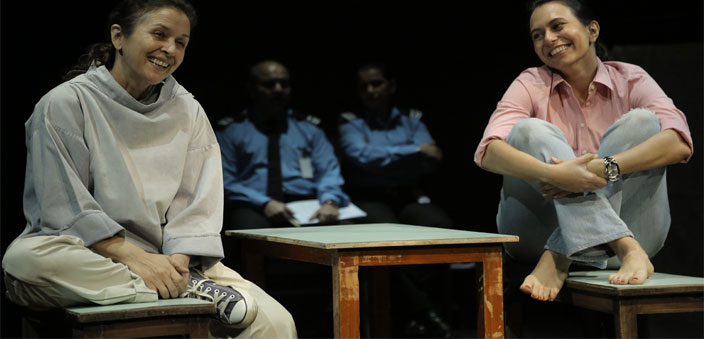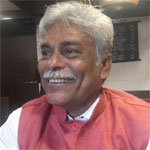Indian culture holds motherhood in high regard. In fact, even today, more often than not, a girl wants to get married to enjoy motherhood, as it is projected as the highest form of joy for a woman. No wonder Indian culture and literature are full of glories of motherhood. Against this backdrop, when one comes across a play like Iron by Rona Munro that talks about the tortuous relationship between a 45-year-old mother and her 25- year-old daughter, it becomes a deeply revealing and disturbing experience.
Iron is a haunting play which tells the story of a mother-daughter relationship and how they try to break through the barriers of time, memories and prison, which separates them. Yes, prison. The mother whose name is Fay, is serving life-time imprisonment as she has killed her husband. She has a daughter Josie who was raised by Josie’s paternal grandmother. Josie was 11-years-old when Fay was taken to prison, and was raised by her paternal grandmother. And now after 15 years, Fay has a visitor, Josie, her daughter. That is how the play starts, and it grips you, keeps you riveted in this psychological drama. The play was first performed at the Traverse Theatre, Edinburgh in July 2002.
The plot
Josie is here to meet her mother. She has never seen a prison from inside. She is a lonely divorcee, and wants to connect with her mother. Her real intention is to rediscover her past, which she has completely forgotten. Iron grips the audience from its very first scene which opens in prison. We get to know about Josie, her imprisoned mother, and how Josie cannot see her mother without authorisation. According to the rules of the prison, a visitor is allowed to meet the inmate only if the prisoner so desires, not otherwise. The woman prison officer takes pity on Josie and finds a way in. The play begins on a high-suspense note. A daughter meeting her mother after a gap of 15 years! And that mother who has killed her husband, Josie’s father? Why does Josie want to meet her now?

Like the audience, even Fay is unsettled when told about Josie wanting to meet her. Somehow, she reconciles with this reality and the meeting takes place, one of the many more that follow shortly, each meeting more unnerving than before. Each meeting between them unravels those hidden memories, secrets which they have not visited for the last 15 years. Josie confesses that she does not remember much of her childhood and whatever she does, is in bit and pieces. Fay helps her put the picture together.
Slowly and steadily Fay gets to know the real intention of Josie’s visits. Josie has been collecting information on her mother’s trial. Josie gets to know that during the trial, her mother never defended herself, never uttered even a word. This intrigues Josie and she confronts Fay. Fay is most unwilling to talk about her past and the murder. Not only this, she does not like the way Josie is taking efforts to get her out of prison. To pursue this case, Josie has taken a part-time job in the same town and devotes most of her time perusing through old city newspapers. She also meets a top attorney and discusses the trial of Fay. All these are just unacceptable to Fay. She tells the prison authorities not to let Josie visit her. Parallel to this is a side-story of two prison guards, one middle-aged male and one single-mother female. The female prison officer has developed a special relationship with Fay and does not like much Josie’s visit as it would loosen her grip on Fay.
The play is performed in the prison where two guards keep overlooking, overhearing the discussions between Fay and Josie. The very idea of setting the play in prison itself is quite novel as it brings the pathos, the walls, the bars, separation between human beings to surface. Imagine talking to one’s mother with two prison guards eavesdropping all the time!
The team
Light arrangement plays a very important role in a play like this. Light design and direction of this play is by Arghya Lahiri. He is quite competent with light design. He is fortunate to have an able cast to play the four characters. Shernaz Patel (Fay), Dilnaz Irani (Josie), Kenner Desai (male prison officer) and Meher Acharia-Dhar (female prison officer), are extremely talented actors. This team under the baton of Arghya Lahiri makes watching Iron a wholly enjoyable experience. The set of prison is properly designed so that in the minimum space maximum impact is achieved. The light design ensures the gloomy atmosphere inside the walls of a prison. Though the focus is constantly on relationship between Fay-Josie and rightly so, one also gets to see in flashes the relationship between Fay and the female prison guard. This woman is rather upset that Josie is constantly visiting Fay whom she thinks is completely under control giving her a sense of power. While watching Iron, I was reminded of Nurse Ratched played by Lousie Fletcher in One flew over the cuckoo’s nest, the Hollywood movie of 1975. Ratched hates Randle McMurp (Jack Nicholson) as he constantly challenges her power in the mental hospital. Plays like Iron set us thinking about the human mind and its needs. Fay is always suspicious of Josie, her daughter. Josie too is more interested in knowing about her past that she barely remembers. Where is so-called true love between mother and her daughter? Plays like Iron should not be missed.


 [/column]
[/column]